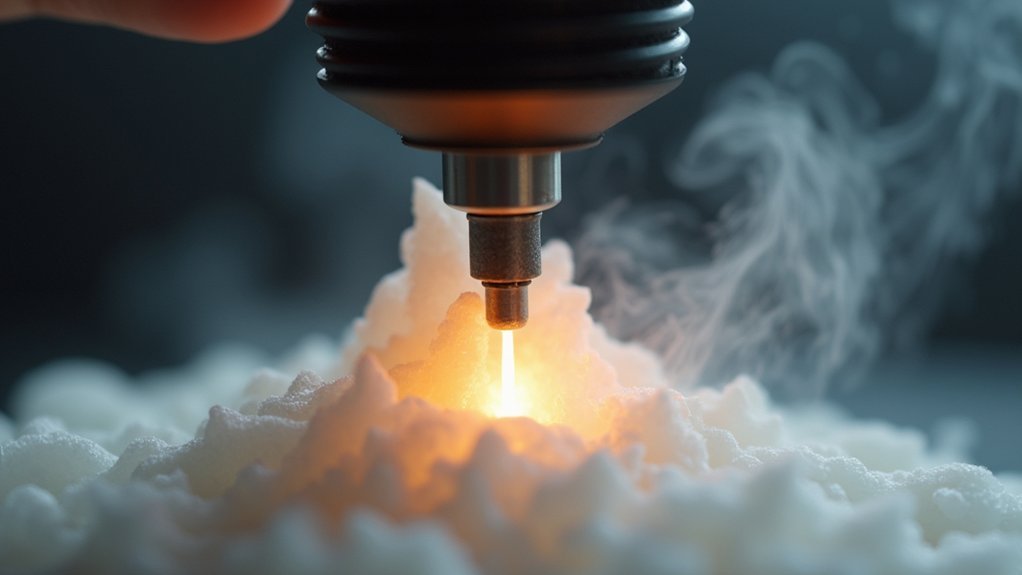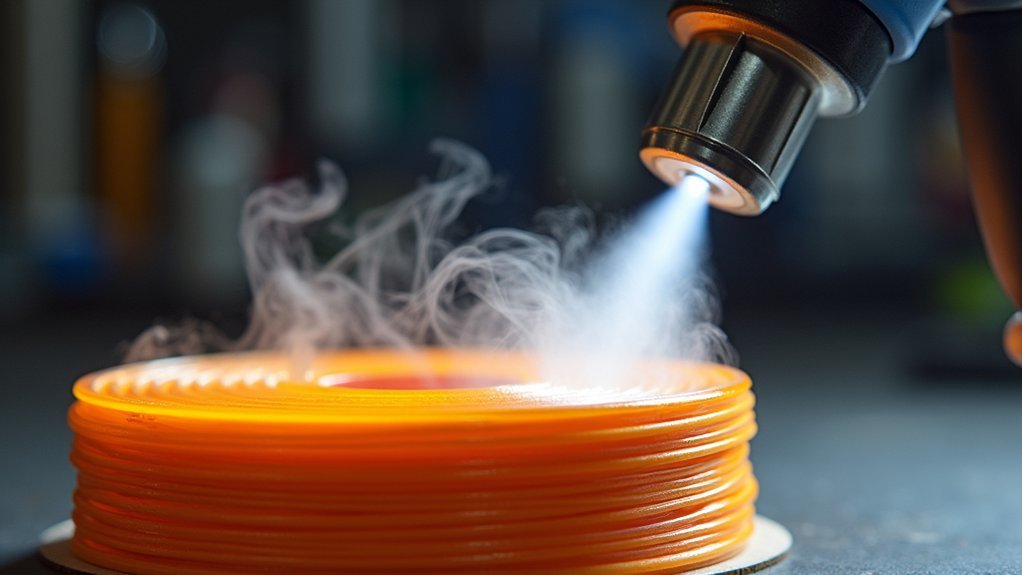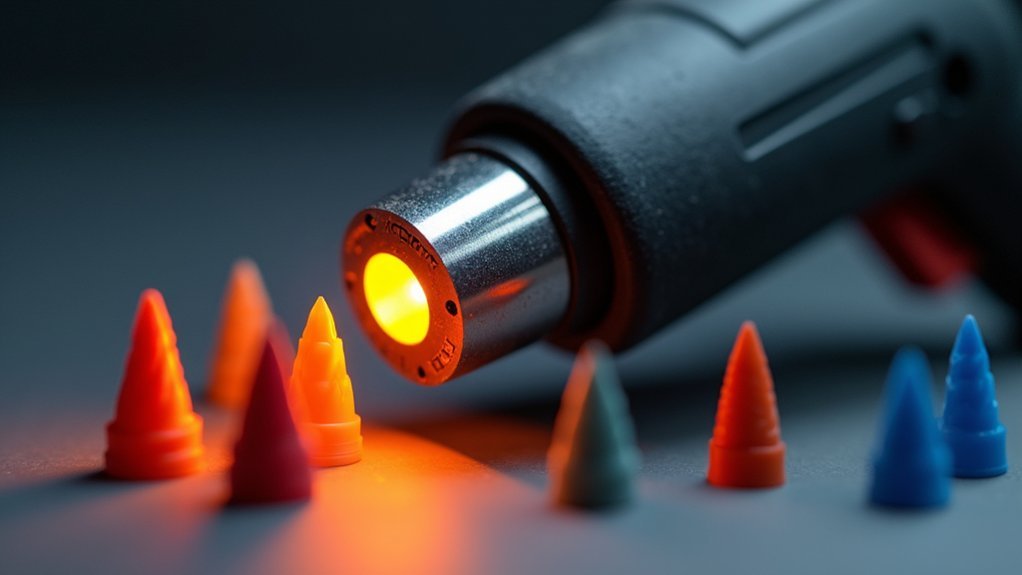You’ll achieve clean support removal by maintaining at least 6 inches distance from your print and using low temperature settings with 5-15 second heat bursts. Apply quick sweeping motions across support areas for even heat distribution, focusing on thicker connections first. Target specific attachment points where supports firmly connect to your model, then use pliers or flush cutters on the softened plastic. Test your technique on scrap pieces before working on final prints, and use light reheating afterward to smooth any surface imperfections for professional-quality results.
Maintain Proper Distance and Temperature Control

The most critical factor in heat gun support removal is maintaining proper distance and temperature control to protect your 3D print from damage.
Keep your heat gun at least 6 inches away from the print surface to prevent overheating and warping. Set the temperature to low settings for controlled heating, particularly with delicate models where print quality matters most.
Maintain 6+ inches distance and use low temperature settings to prevent overheating and preserve delicate print quality.
When using a heat gun for supports, apply heat in short 5-15 second bursts rather than continuous exposure. This approach creates softer supports without damaging surrounding areas.
Always test on scrap pieces first to determine ideal distance and temperature settings for your specific material. Proper technique during the removal process guarantees clean results while preserving your model’s integrity and surface finish.
Use Quick Sweeping Motions for Even Heat Distribution
Beyond controlling distance and temperature, your motion technique plays an essential role in achieving uniform heat distribution across support structures. Quick sweeping motions prevent heat concentration in one area, which could warp your print or create sharp edges.
When heat softens supports evenly, support removal easier becomes achievable without damaging your model.
- Move the heat gun in continuous back-and-forth motions across support areas
- Keep steady movement speed to avoid overheating specific sections
- Focus on thicker support connections first, then move to thinner areas
- Test effectiveness on scrap pieces before working on final prints
- Rinse softened supports with warm water after heating
Using the right tools like flush cutters alongside proper motion technique maximizes results.
Always wear safety gear throughout the process for protection.
Target Specific Support Connection Points

When removing supports from your 3D prints, precision targeting of connection points yields far better results than randomly heating entire support structures.
You’ll want to target specific support connection points where the support material attaches most firmly to your model, typically at the base or contact zones.
Apply heat directly to these targeted areas for 5 to 15 seconds to soften the plastic. Once heated, grip the support structure with needle-nose pliers at the connection point for better leverage during easier removal.
Keep your heat gun at least 6 inches away to avoid damaging surrounding areas. This focused approach lets you remove supports efficiently while protecting your print’s integrity.
Combine Heat Application With Removal Tools
Building on this targeted heating approach, pairing your heat gun with the right removal tools transforms stubborn support removal into a streamlined process.
Heat application softens the material while specialized removal tools provide the leverage and precision needed for effective support removal without compromising print integrity.
Here’s how to combine heat with tools for ideal support extraction:
- Apply heat for 5-15 seconds to soften supports before using needle-nose pliers for enhanced grip and control
- Use flush cutters alongside heat application to cleanly sever support connections from your 3D prints
- Maintain 6 inches distance between heat gun and model while manipulating removal tools
- Test heat duration on scrap pieces before working on final prints
- Twist and pull heated supports with pliers for controlled removal
Post-Heat Finishing Techniques for Surface Smoothing

Once you’ve successfully removed supports with heat application, the finishing process becomes essential for achieving professional-looking results. Post processing with reheating techniques transforms your print’s surface quality from rough to professionally smooth.
After removing supports, lightly reheat affected areas to smooth imperfections by remelting the top layer. Keep your heat gun at least 6 inches away while using sweeping motions to prevent overheating specific spots. Quick applications of 5-15 seconds restore the filament’s original color, minimizing support marks.
| Technique | Application Time |
|---|---|
| Light reheating | 5-15 seconds |
| Color restoration | 10 seconds |
| Surface smoothing | 8-12 seconds |
| Detail finishing | 3-8 seconds |
| Final touch-ups | 5 seconds |
For detailed work, use smaller nozzles targeting specific areas without affecting surrounding features, ensuring smooth surfaces regardless of original support density.
Frequently Asked Questions
How Do You Remove PLA Supports With a Heat Gun?
You’ll heat your PLA print from six inches away using short bursts of five to fifteen seconds. Move the heat gun in sweeping motions, then peel off the softened supports carefully.
How Do You Dissolve 3D Print Supports?
You’ll submerge your print in warm water around 60°C for PVA supports or limonene solution for HIPS supports. Stir the liquid to accelerate dissolution, then rinse and dry thoroughly.
Should You Remove Supports Before or After Curing?
You should remove supports after curing for most prints. Curing strengthens the material and prevents damage to delicate features. However, check your filament manufacturer’s guidelines since soluble supports may require different timing.
What Are the Best Pliers for Removing 3D Print Supports?
You’ll want needle-nose pliers for precision work in tight spaces, flat-nose pliers for larger supports, and flush cutters for clean base cuts. Choose ergonomic, high-carbon steel tools to reduce fatigue.





Leave a Reply